Analysis of McDonald's Green Sourcing Practices and Recommendations
VerifiedAdded on 2023/06/09
|8
|2303
|461
Report
AI Summary
This report examines McDonald's green sourcing process, focusing on the company's current practices for sourcing ingredients, particularly potatoes, used in their French fries. It highlights the environmental and health concerns associated with pesticide use on potato farms and the sourcing of other ingredients like canola and soybean oil. The report provides a detailed analysis of the unsustainable aspects of McDonald's current supply chain, including the use of genetically modified ingredients and potentially hazardous additives. Furthermore, it offers recommendations for implementing a green sourcing process, including engaging stakeholders, identifying alternative ingredients, assessing the supply market, defining sourcing strategies, and monitoring the procurement process. The report emphasizes the importance of sustainable procurement practices to mitigate environmental impact and improve the company's public image.

Running head: GREEN SOURCING PROCESS
Green Sourcing Process
Name
Institutional Affiliations
Green Sourcing Process
Name
Institutional Affiliations
Paraphrase This Document
Need a fresh take? Get an instant paraphrase of this document with our AI Paraphraser
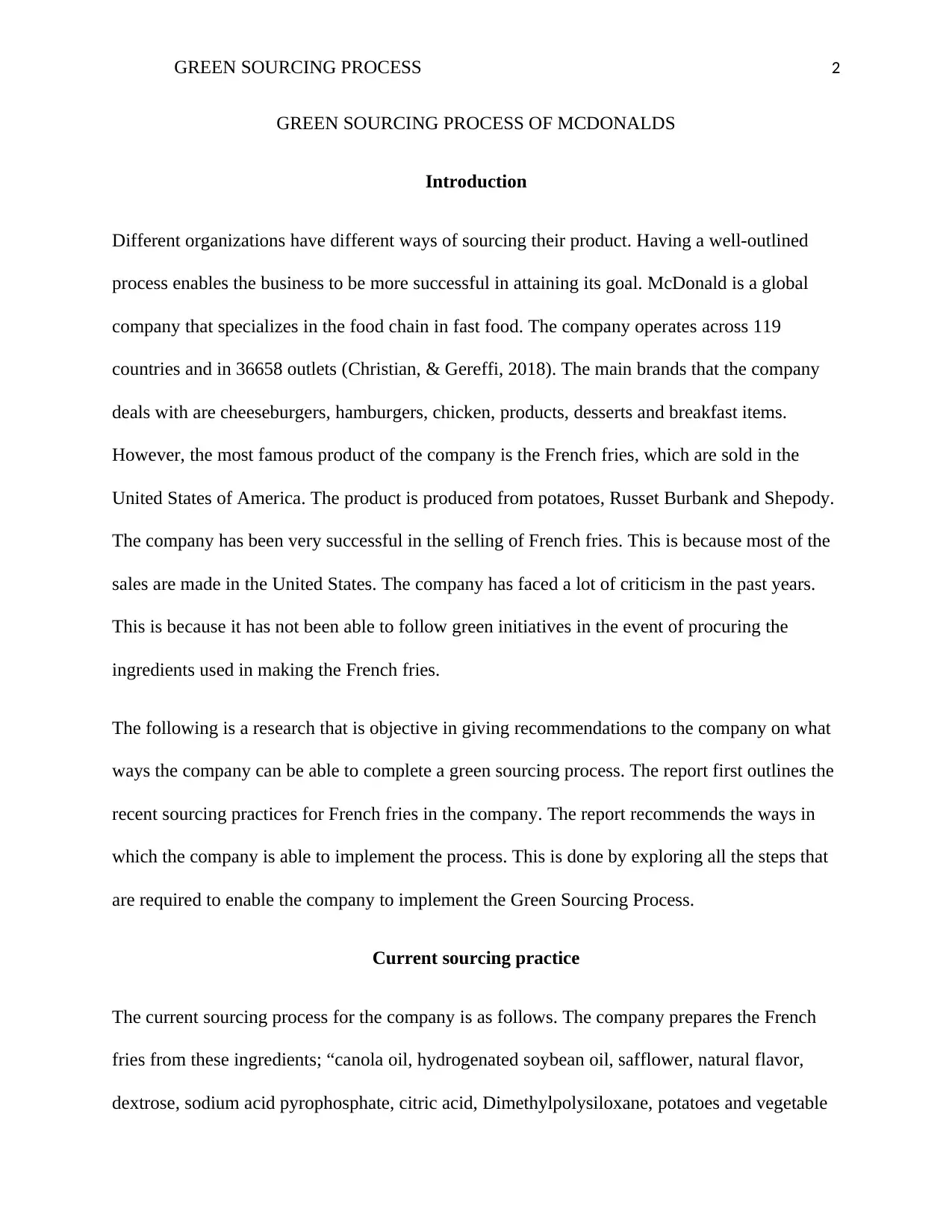
GREEN SOURCING PROCESS 2
GREEN SOURCING PROCESS OF MCDONALDS
Introduction
Different organizations have different ways of sourcing their product. Having a well-outlined
process enables the business to be more successful in attaining its goal. McDonald is a global
company that specializes in the food chain in fast food. The company operates across 119
countries and in 36658 outlets (Christian, & Gereffi, 2018). The main brands that the company
deals with are cheeseburgers, hamburgers, chicken, products, desserts and breakfast items.
However, the most famous product of the company is the French fries, which are sold in the
United States of America. The product is produced from potatoes, Russet Burbank and Shepody.
The company has been very successful in the selling of French fries. This is because most of the
sales are made in the United States. The company has faced a lot of criticism in the past years.
This is because it has not been able to follow green initiatives in the event of procuring the
ingredients used in making the French fries.
The following is a research that is objective in giving recommendations to the company on what
ways the company can be able to complete a green sourcing process. The report first outlines the
recent sourcing practices for French fries in the company. The report recommends the ways in
which the company is able to implement the process. This is done by exploring all the steps that
are required to enable the company to implement the Green Sourcing Process.
Current sourcing practice
The current sourcing process for the company is as follows. The company prepares the French
fries from these ingredients; “canola oil, hydrogenated soybean oil, safflower, natural flavor,
dextrose, sodium acid pyrophosphate, citric acid, Dimethylpolysiloxane, potatoes and vegetable
GREEN SOURCING PROCESS OF MCDONALDS
Introduction
Different organizations have different ways of sourcing their product. Having a well-outlined
process enables the business to be more successful in attaining its goal. McDonald is a global
company that specializes in the food chain in fast food. The company operates across 119
countries and in 36658 outlets (Christian, & Gereffi, 2018). The main brands that the company
deals with are cheeseburgers, hamburgers, chicken, products, desserts and breakfast items.
However, the most famous product of the company is the French fries, which are sold in the
United States of America. The product is produced from potatoes, Russet Burbank and Shepody.
The company has been very successful in the selling of French fries. This is because most of the
sales are made in the United States. The company has faced a lot of criticism in the past years.
This is because it has not been able to follow green initiatives in the event of procuring the
ingredients used in making the French fries.
The following is a research that is objective in giving recommendations to the company on what
ways the company can be able to complete a green sourcing process. The report first outlines the
recent sourcing practices for French fries in the company. The report recommends the ways in
which the company is able to implement the process. This is done by exploring all the steps that
are required to enable the company to implement the Green Sourcing Process.
Current sourcing practice
The current sourcing process for the company is as follows. The company prepares the French
fries from these ingredients; “canola oil, hydrogenated soybean oil, safflower, natural flavor,
dextrose, sodium acid pyrophosphate, citric acid, Dimethylpolysiloxane, potatoes and vegetable

GREEN SOURCING PROCESS 3
oil for frying” (Jackson, et al 2018). The company has been able to portray their commodity as
the most famous commodity worldwide. However, there are many weaknesses in the company
unsustainable process of sourcing the ingredients that are used in the preparation. The major
ingredients used in the preparation of the French fries are the potatoes. In one year, the company
uses around 3.4 billion pounds to purchase potatoes for the whole United States of America.
The company prefers to use russet Burbank type of potato spices in the production of the French
fries. However, that kind of potato spices is subject to rooting and having other diseases which
leave a farmer with no option but to use large amounts of pesticides to protect their crops. The
people living around the potato farms are always affected by the use of pesticides in the potato
farms. This is because the pesticides are blown by the wind to the area of residents of many
people from the potato farms (Lim, Kang, & Kim, 2017). The idea is that the type of potatoes
that the company use is to make the French fries are affected by pesticides to a greater extent.
The pesticides have a greater negative effect on the people living around the farms. From the
environmental protection agency report, it is clear that nearly 98.5% of the potato farms in
Northern Minnesota are sprayed after every five days. In addition, it is clear those pesticides
contains carcinogens such as Chlorothalonil, which affects the nervous systems of children.
It is clear that the procurement practice of the company is unsustainable. This is because
pesticides applied in potato farms are a great pollutant to the environment. The impact is majorly
affecting human and other animals in the environment. In addition, the pesticide drift has an
ecological effect that leads to great economic losses. From the environment protection agency,
there is a lot of money that is wasted by the farmer on pesticides. The farmers waste around 70
million pounds on pesticides from the effects of the pesticide drift per year. Moreover, many
complaints are raised by people in the state and local agencies about the effects that are brought
oil for frying” (Jackson, et al 2018). The company has been able to portray their commodity as
the most famous commodity worldwide. However, there are many weaknesses in the company
unsustainable process of sourcing the ingredients that are used in the preparation. The major
ingredients used in the preparation of the French fries are the potatoes. In one year, the company
uses around 3.4 billion pounds to purchase potatoes for the whole United States of America.
The company prefers to use russet Burbank type of potato spices in the production of the French
fries. However, that kind of potato spices is subject to rooting and having other diseases which
leave a farmer with no option but to use large amounts of pesticides to protect their crops. The
people living around the potato farms are always affected by the use of pesticides in the potato
farms. This is because the pesticides are blown by the wind to the area of residents of many
people from the potato farms (Lim, Kang, & Kim, 2017). The idea is that the type of potatoes
that the company use is to make the French fries are affected by pesticides to a greater extent.
The pesticides have a greater negative effect on the people living around the farms. From the
environmental protection agency report, it is clear that nearly 98.5% of the potato farms in
Northern Minnesota are sprayed after every five days. In addition, it is clear those pesticides
contains carcinogens such as Chlorothalonil, which affects the nervous systems of children.
It is clear that the procurement practice of the company is unsustainable. This is because
pesticides applied in potato farms are a great pollutant to the environment. The impact is majorly
affecting human and other animals in the environment. In addition, the pesticide drift has an
ecological effect that leads to great economic losses. From the environment protection agency,
there is a lot of money that is wasted by the farmer on pesticides. The farmers waste around 70
million pounds on pesticides from the effects of the pesticide drift per year. Moreover, many
complaints are raised by people in the state and local agencies about the effects that are brought
⊘ This is a preview!⊘
Do you want full access?
Subscribe today to unlock all pages.

Trusted by 1+ million students worldwide
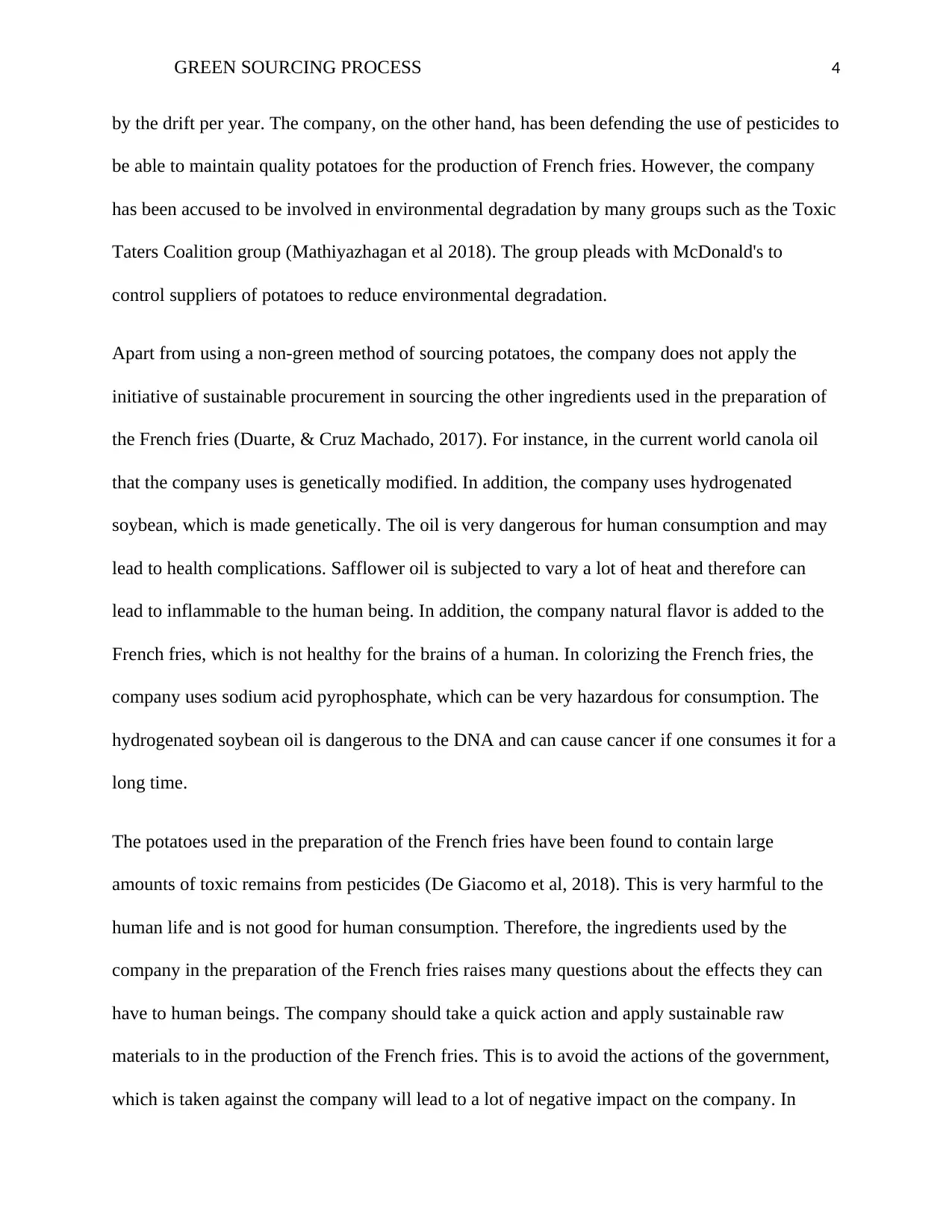
GREEN SOURCING PROCESS 4
by the drift per year. The company, on the other hand, has been defending the use of pesticides to
be able to maintain quality potatoes for the production of French fries. However, the company
has been accused to be involved in environmental degradation by many groups such as the Toxic
Taters Coalition group (Mathiyazhagan et al 2018). The group pleads with McDonald's to
control suppliers of potatoes to reduce environmental degradation.
Apart from using a non-green method of sourcing potatoes, the company does not apply the
initiative of sustainable procurement in sourcing the other ingredients used in the preparation of
the French fries (Duarte, & Cruz Machado, 2017). For instance, in the current world canola oil
that the company uses is genetically modified. In addition, the company uses hydrogenated
soybean, which is made genetically. The oil is very dangerous for human consumption and may
lead to health complications. Safflower oil is subjected to vary a lot of heat and therefore can
lead to inflammable to the human being. In addition, the company natural flavor is added to the
French fries, which is not healthy for the brains of a human. In colorizing the French fries, the
company uses sodium acid pyrophosphate, which can be very hazardous for consumption. The
hydrogenated soybean oil is dangerous to the DNA and can cause cancer if one consumes it for a
long time.
The potatoes used in the preparation of the French fries have been found to contain large
amounts of toxic remains from pesticides (De Giacomo et al, 2018). This is very harmful to the
human life and is not good for human consumption. Therefore, the ingredients used by the
company in the preparation of the French fries raises many questions about the effects they can
have to human beings. The company should take a quick action and apply sustainable raw
materials to in the production of the French fries. This is to avoid the actions of the government,
which is taken against the company will lead to a lot of negative impact on the company. In
by the drift per year. The company, on the other hand, has been defending the use of pesticides to
be able to maintain quality potatoes for the production of French fries. However, the company
has been accused to be involved in environmental degradation by many groups such as the Toxic
Taters Coalition group (Mathiyazhagan et al 2018). The group pleads with McDonald's to
control suppliers of potatoes to reduce environmental degradation.
Apart from using a non-green method of sourcing potatoes, the company does not apply the
initiative of sustainable procurement in sourcing the other ingredients used in the preparation of
the French fries (Duarte, & Cruz Machado, 2017). For instance, in the current world canola oil
that the company uses is genetically modified. In addition, the company uses hydrogenated
soybean, which is made genetically. The oil is very dangerous for human consumption and may
lead to health complications. Safflower oil is subjected to vary a lot of heat and therefore can
lead to inflammable to the human being. In addition, the company natural flavor is added to the
French fries, which is not healthy for the brains of a human. In colorizing the French fries, the
company uses sodium acid pyrophosphate, which can be very hazardous for consumption. The
hydrogenated soybean oil is dangerous to the DNA and can cause cancer if one consumes it for a
long time.
The potatoes used in the preparation of the French fries have been found to contain large
amounts of toxic remains from pesticides (De Giacomo et al, 2018). This is very harmful to the
human life and is not good for human consumption. Therefore, the ingredients used by the
company in the preparation of the French fries raises many questions about the effects they can
have to human beings. The company should take a quick action and apply sustainable raw
materials to in the production of the French fries. This is to avoid the actions of the government,
which is taken against the company will lead to a lot of negative impact on the company. In
Paraphrase This Document
Need a fresh take? Get an instant paraphrase of this document with our AI Paraphraser
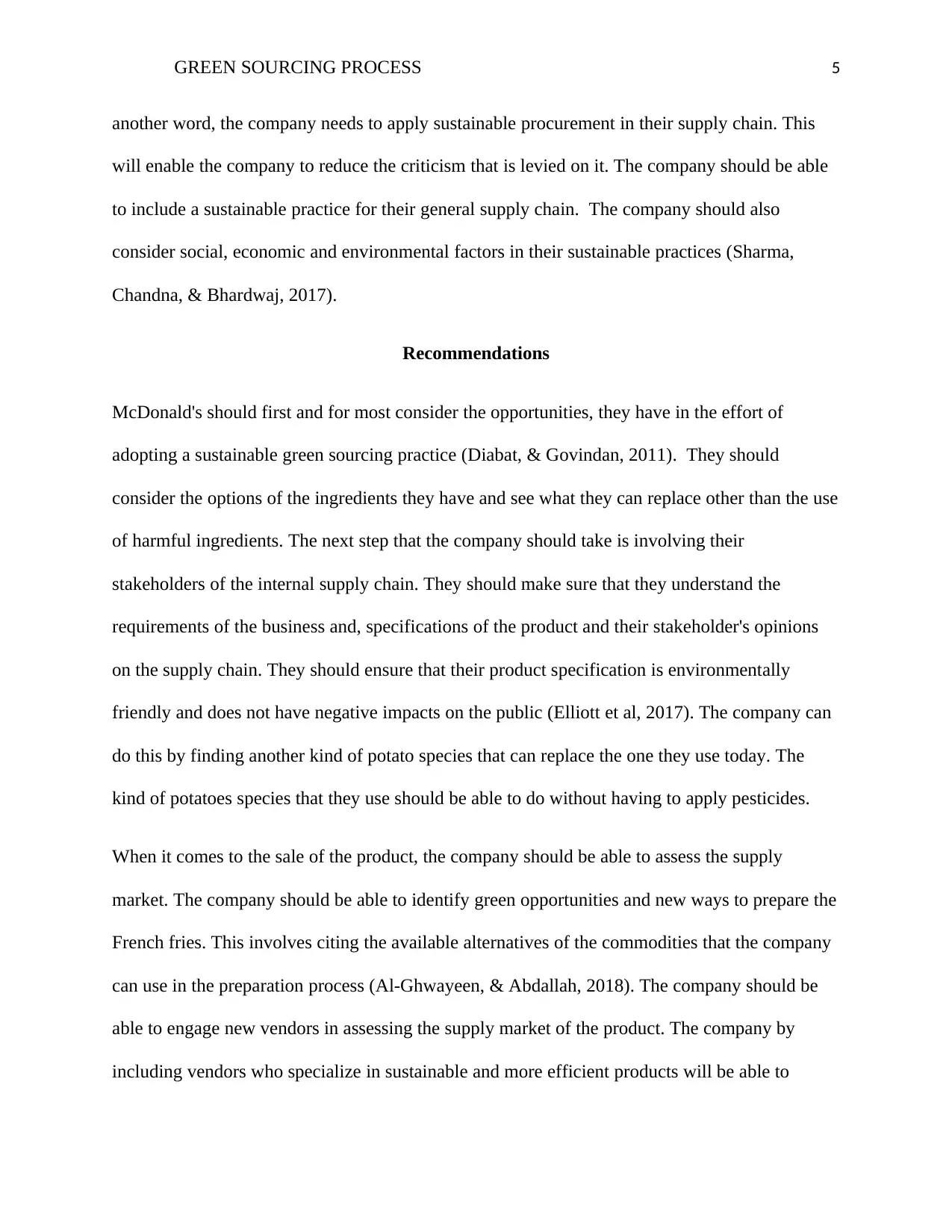
GREEN SOURCING PROCESS 5
another word, the company needs to apply sustainable procurement in their supply chain. This
will enable the company to reduce the criticism that is levied on it. The company should be able
to include a sustainable practice for their general supply chain. The company should also
consider social, economic and environmental factors in their sustainable practices (Sharma,
Chandna, & Bhardwaj, 2017).
Recommendations
McDonald's should first and for most consider the opportunities, they have in the effort of
adopting a sustainable green sourcing practice (Diabat, & Govindan, 2011). They should
consider the options of the ingredients they have and see what they can replace other than the use
of harmful ingredients. The next step that the company should take is involving their
stakeholders of the internal supply chain. They should make sure that they understand the
requirements of the business and, specifications of the product and their stakeholder's opinions
on the supply chain. They should ensure that their product specification is environmentally
friendly and does not have negative impacts on the public (Elliott et al, 2017). The company can
do this by finding another kind of potato species that can replace the one they use today. The
kind of potatoes species that they use should be able to do without having to apply pesticides.
When it comes to the sale of the product, the company should be able to assess the supply
market. The company should be able to identify green opportunities and new ways to prepare the
French fries. This involves citing the available alternatives of the commodities that the company
can use in the preparation process (Al-Ghwayeen, & Abdallah, 2018). The company should be
able to engage new vendors in assessing the supply market of the product. The company by
including vendors who specialize in sustainable and more efficient products will be able to
another word, the company needs to apply sustainable procurement in their supply chain. This
will enable the company to reduce the criticism that is levied on it. The company should be able
to include a sustainable practice for their general supply chain. The company should also
consider social, economic and environmental factors in their sustainable practices (Sharma,
Chandna, & Bhardwaj, 2017).
Recommendations
McDonald's should first and for most consider the opportunities, they have in the effort of
adopting a sustainable green sourcing practice (Diabat, & Govindan, 2011). They should
consider the options of the ingredients they have and see what they can replace other than the use
of harmful ingredients. The next step that the company should take is involving their
stakeholders of the internal supply chain. They should make sure that they understand the
requirements of the business and, specifications of the product and their stakeholder's opinions
on the supply chain. They should ensure that their product specification is environmentally
friendly and does not have negative impacts on the public (Elliott et al, 2017). The company can
do this by finding another kind of potato species that can replace the one they use today. The
kind of potatoes species that they use should be able to do without having to apply pesticides.
When it comes to the sale of the product, the company should be able to assess the supply
market. The company should be able to identify green opportunities and new ways to prepare the
French fries. This involves citing the available alternatives of the commodities that the company
can use in the preparation process (Al-Ghwayeen, & Abdallah, 2018). The company should be
able to engage new vendors in assessing the supply market of the product. The company by
including vendors who specialize in sustainable and more efficient products will be able to
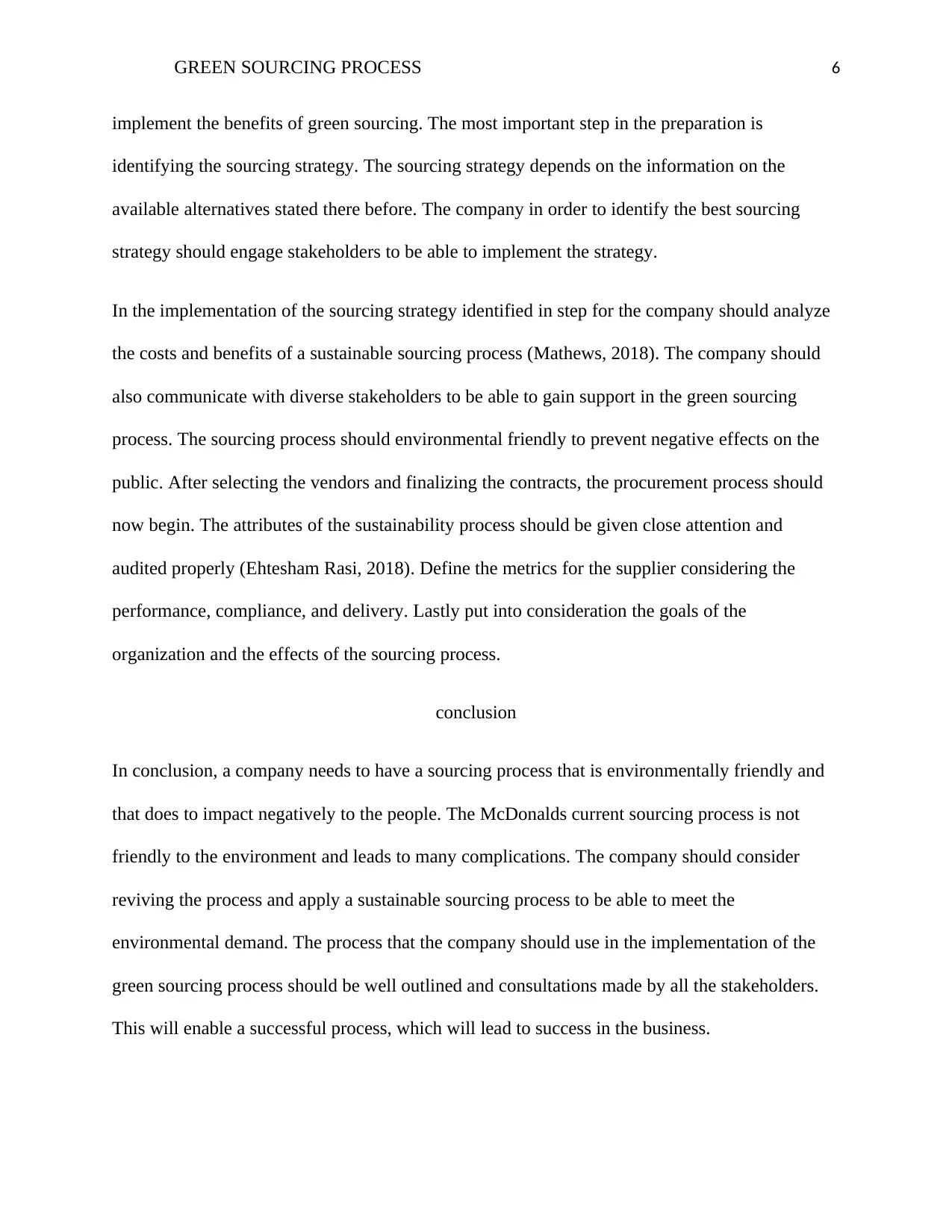
GREEN SOURCING PROCESS 6
implement the benefits of green sourcing. The most important step in the preparation is
identifying the sourcing strategy. The sourcing strategy depends on the information on the
available alternatives stated there before. The company in order to identify the best sourcing
strategy should engage stakeholders to be able to implement the strategy.
In the implementation of the sourcing strategy identified in step for the company should analyze
the costs and benefits of a sustainable sourcing process (Mathews, 2018). The company should
also communicate with diverse stakeholders to be able to gain support in the green sourcing
process. The sourcing process should environmental friendly to prevent negative effects on the
public. After selecting the vendors and finalizing the contracts, the procurement process should
now begin. The attributes of the sustainability process should be given close attention and
audited properly (Ehtesham Rasi, 2018). Define the metrics for the supplier considering the
performance, compliance, and delivery. Lastly put into consideration the goals of the
organization and the effects of the sourcing process.
conclusion
In conclusion, a company needs to have a sourcing process that is environmentally friendly and
that does to impact negatively to the people. The McDonalds current sourcing process is not
friendly to the environment and leads to many complications. The company should consider
reviving the process and apply a sustainable sourcing process to be able to meet the
environmental demand. The process that the company should use in the implementation of the
green sourcing process should be well outlined and consultations made by all the stakeholders.
This will enable a successful process, which will lead to success in the business.
implement the benefits of green sourcing. The most important step in the preparation is
identifying the sourcing strategy. The sourcing strategy depends on the information on the
available alternatives stated there before. The company in order to identify the best sourcing
strategy should engage stakeholders to be able to implement the strategy.
In the implementation of the sourcing strategy identified in step for the company should analyze
the costs and benefits of a sustainable sourcing process (Mathews, 2018). The company should
also communicate with diverse stakeholders to be able to gain support in the green sourcing
process. The sourcing process should environmental friendly to prevent negative effects on the
public. After selecting the vendors and finalizing the contracts, the procurement process should
now begin. The attributes of the sustainability process should be given close attention and
audited properly (Ehtesham Rasi, 2018). Define the metrics for the supplier considering the
performance, compliance, and delivery. Lastly put into consideration the goals of the
organization and the effects of the sourcing process.
conclusion
In conclusion, a company needs to have a sourcing process that is environmentally friendly and
that does to impact negatively to the people. The McDonalds current sourcing process is not
friendly to the environment and leads to many complications. The company should consider
reviving the process and apply a sustainable sourcing process to be able to meet the
environmental demand. The process that the company should use in the implementation of the
green sourcing process should be well outlined and consultations made by all the stakeholders.
This will enable a successful process, which will lead to success in the business.
⊘ This is a preview!⊘
Do you want full access?
Subscribe today to unlock all pages.

Trusted by 1+ million students worldwide
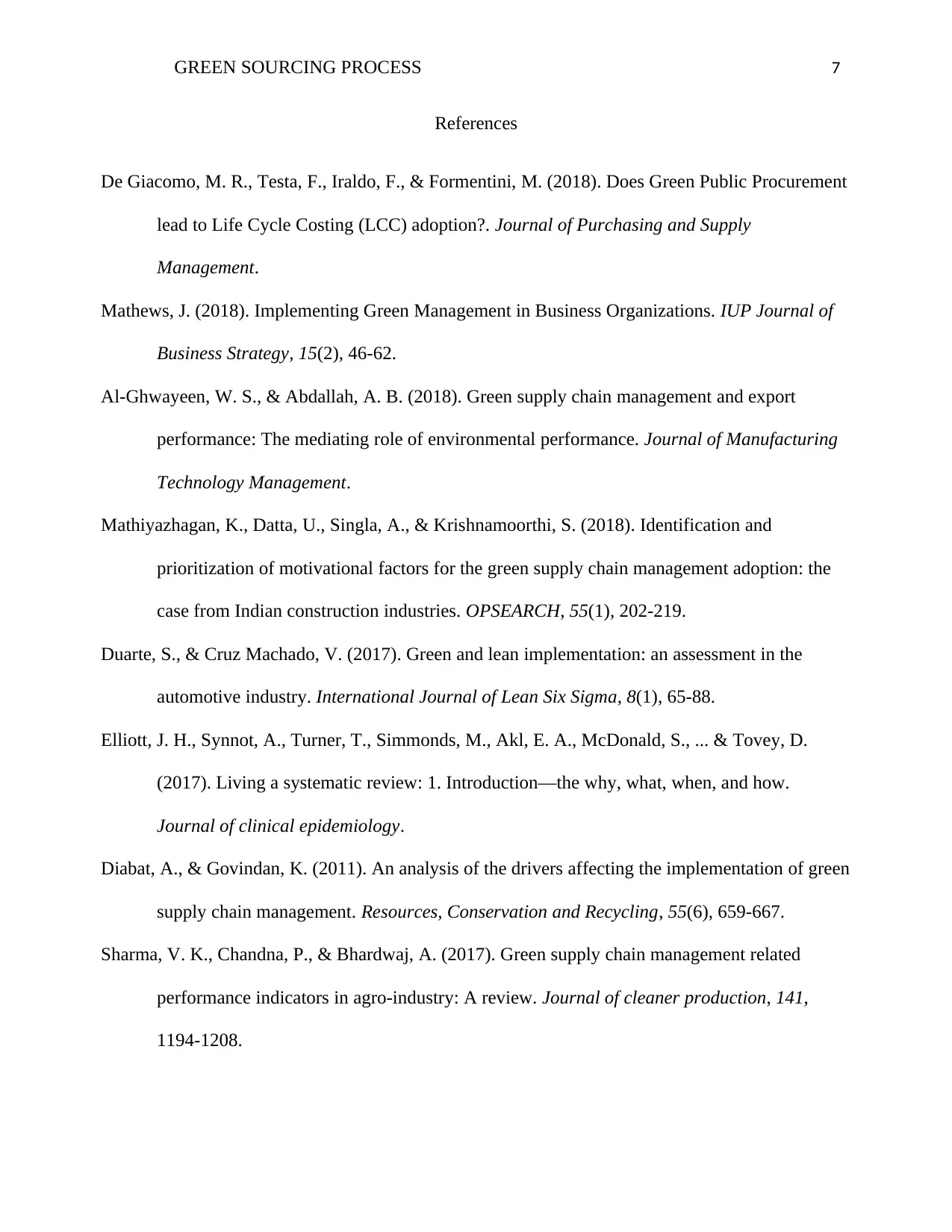
GREEN SOURCING PROCESS 7
References
De Giacomo, M. R., Testa, F., Iraldo, F., & Formentini, M. (2018). Does Green Public Procurement
lead to Life Cycle Costing (LCC) adoption?. Journal of Purchasing and Supply
Management.
Mathews, J. (2018). Implementing Green Management in Business Organizations. IUP Journal of
Business Strategy, 15(2), 46-62.
Al-Ghwayeen, W. S., & Abdallah, A. B. (2018). Green supply chain management and export
performance: The mediating role of environmental performance. Journal of Manufacturing
Technology Management.
Mathiyazhagan, K., Datta, U., Singla, A., & Krishnamoorthi, S. (2018). Identification and
prioritization of motivational factors for the green supply chain management adoption: the
case from Indian construction industries. OPSEARCH, 55(1), 202-219.
Duarte, S., & Cruz Machado, V. (2017). Green and lean implementation: an assessment in the
automotive industry. International Journal of Lean Six Sigma, 8(1), 65-88.
Elliott, J. H., Synnot, A., Turner, T., Simmonds, M., Akl, E. A., McDonald, S., ... & Tovey, D.
(2017). Living a systematic review: 1. Introduction—the why, what, when, and how.
Journal of clinical epidemiology.
Diabat, A., & Govindan, K. (2011). An analysis of the drivers affecting the implementation of green
supply chain management. Resources, Conservation and Recycling, 55(6), 659-667.
Sharma, V. K., Chandna, P., & Bhardwaj, A. (2017). Green supply chain management related
performance indicators in agro-industry: A review. Journal of cleaner production, 141,
1194-1208.
References
De Giacomo, M. R., Testa, F., Iraldo, F., & Formentini, M. (2018). Does Green Public Procurement
lead to Life Cycle Costing (LCC) adoption?. Journal of Purchasing and Supply
Management.
Mathews, J. (2018). Implementing Green Management in Business Organizations. IUP Journal of
Business Strategy, 15(2), 46-62.
Al-Ghwayeen, W. S., & Abdallah, A. B. (2018). Green supply chain management and export
performance: The mediating role of environmental performance. Journal of Manufacturing
Technology Management.
Mathiyazhagan, K., Datta, U., Singla, A., & Krishnamoorthi, S. (2018). Identification and
prioritization of motivational factors for the green supply chain management adoption: the
case from Indian construction industries. OPSEARCH, 55(1), 202-219.
Duarte, S., & Cruz Machado, V. (2017). Green and lean implementation: an assessment in the
automotive industry. International Journal of Lean Six Sigma, 8(1), 65-88.
Elliott, J. H., Synnot, A., Turner, T., Simmonds, M., Akl, E. A., McDonald, S., ... & Tovey, D.
(2017). Living a systematic review: 1. Introduction—the why, what, when, and how.
Journal of clinical epidemiology.
Diabat, A., & Govindan, K. (2011). An analysis of the drivers affecting the implementation of green
supply chain management. Resources, Conservation and Recycling, 55(6), 659-667.
Sharma, V. K., Chandna, P., & Bhardwaj, A. (2017). Green supply chain management related
performance indicators in agro-industry: A review. Journal of cleaner production, 141,
1194-1208.
Paraphrase This Document
Need a fresh take? Get an instant paraphrase of this document with our AI Paraphraser
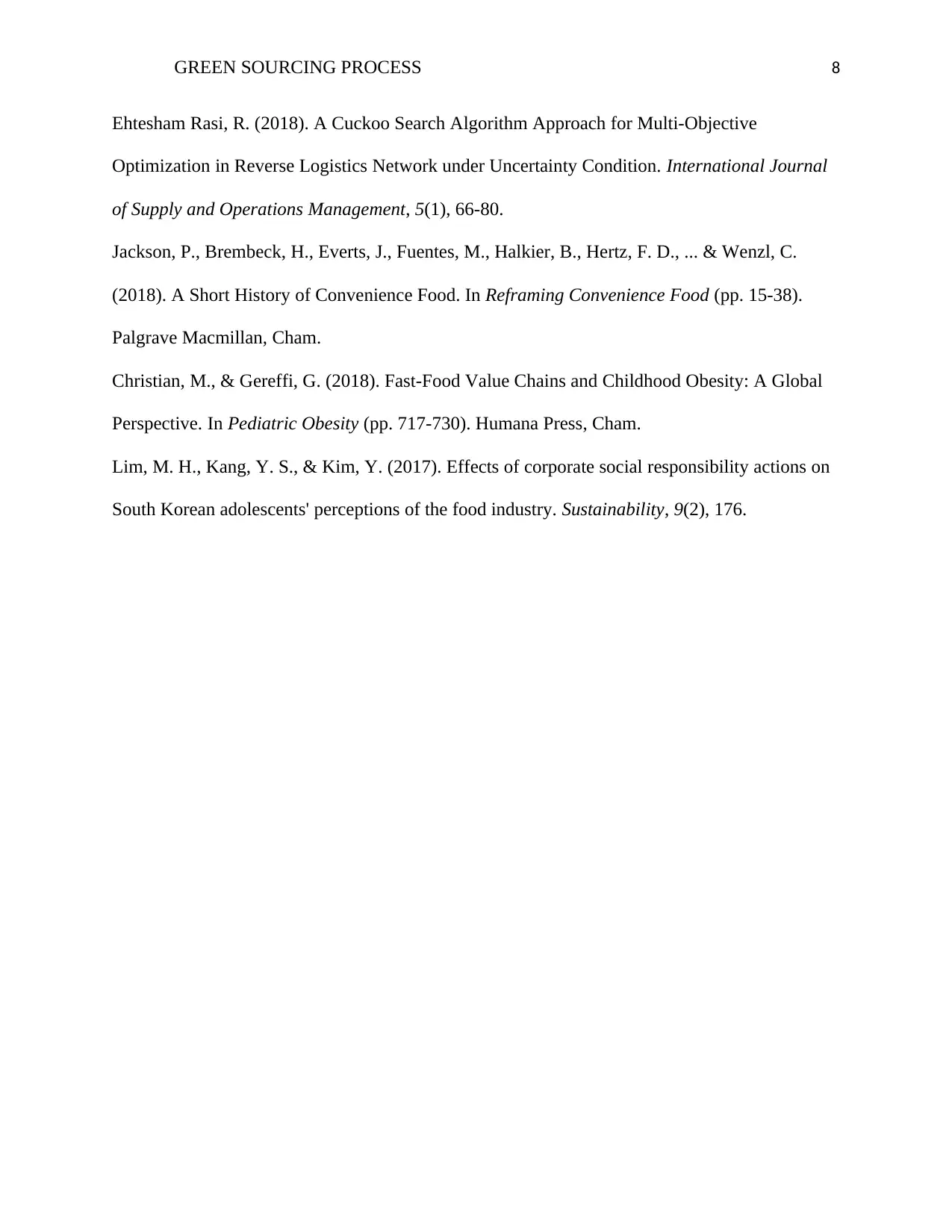
GREEN SOURCING PROCESS 8
Ehtesham Rasi, R. (2018). A Cuckoo Search Algorithm Approach for Multi-Objective
Optimization in Reverse Logistics Network under Uncertainty Condition. International Journal
of Supply and Operations Management, 5(1), 66-80.
Jackson, P., Brembeck, H., Everts, J., Fuentes, M., Halkier, B., Hertz, F. D., ... & Wenzl, C.
(2018). A Short History of Convenience Food. In Reframing Convenience Food (pp. 15-38).
Palgrave Macmillan, Cham.
Christian, M., & Gereffi, G. (2018). Fast-Food Value Chains and Childhood Obesity: A Global
Perspective. In Pediatric Obesity (pp. 717-730). Humana Press, Cham.
Lim, M. H., Kang, Y. S., & Kim, Y. (2017). Effects of corporate social responsibility actions on
South Korean adolescents' perceptions of the food industry. Sustainability, 9(2), 176.
Ehtesham Rasi, R. (2018). A Cuckoo Search Algorithm Approach for Multi-Objective
Optimization in Reverse Logistics Network under Uncertainty Condition. International Journal
of Supply and Operations Management, 5(1), 66-80.
Jackson, P., Brembeck, H., Everts, J., Fuentes, M., Halkier, B., Hertz, F. D., ... & Wenzl, C.
(2018). A Short History of Convenience Food. In Reframing Convenience Food (pp. 15-38).
Palgrave Macmillan, Cham.
Christian, M., & Gereffi, G. (2018). Fast-Food Value Chains and Childhood Obesity: A Global
Perspective. In Pediatric Obesity (pp. 717-730). Humana Press, Cham.
Lim, M. H., Kang, Y. S., & Kim, Y. (2017). Effects of corporate social responsibility actions on
South Korean adolescents' perceptions of the food industry. Sustainability, 9(2), 176.
1 out of 8
Your All-in-One AI-Powered Toolkit for Academic Success.
+13062052269
info@desklib.com
Available 24*7 on WhatsApp / Email
![[object Object]](/_next/static/media/star-bottom.7253800d.svg)
Unlock your academic potential
Copyright © 2020–2025 A2Z Services. All Rights Reserved. Developed and managed by ZUCOL.

